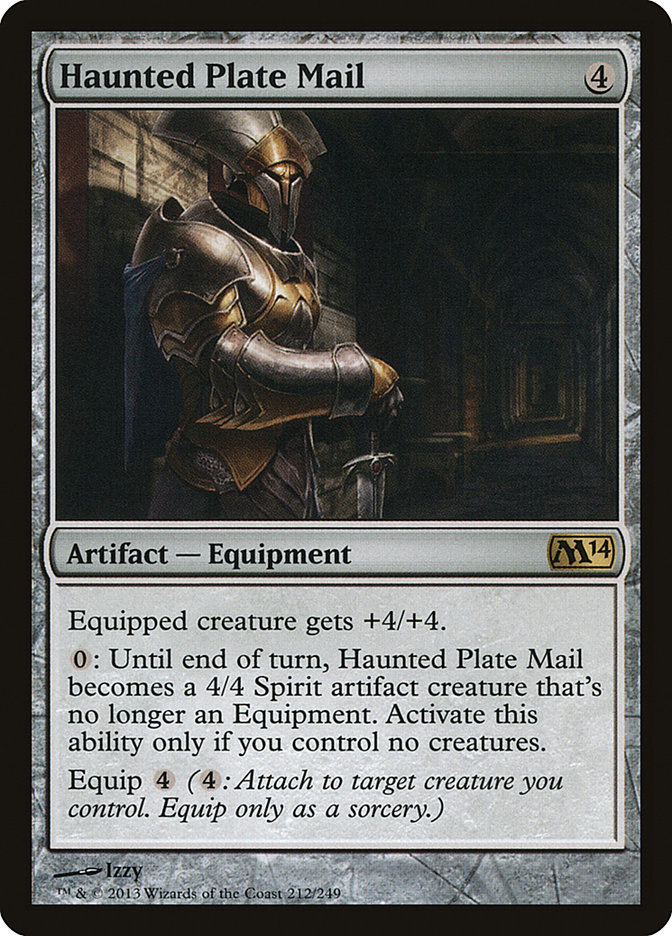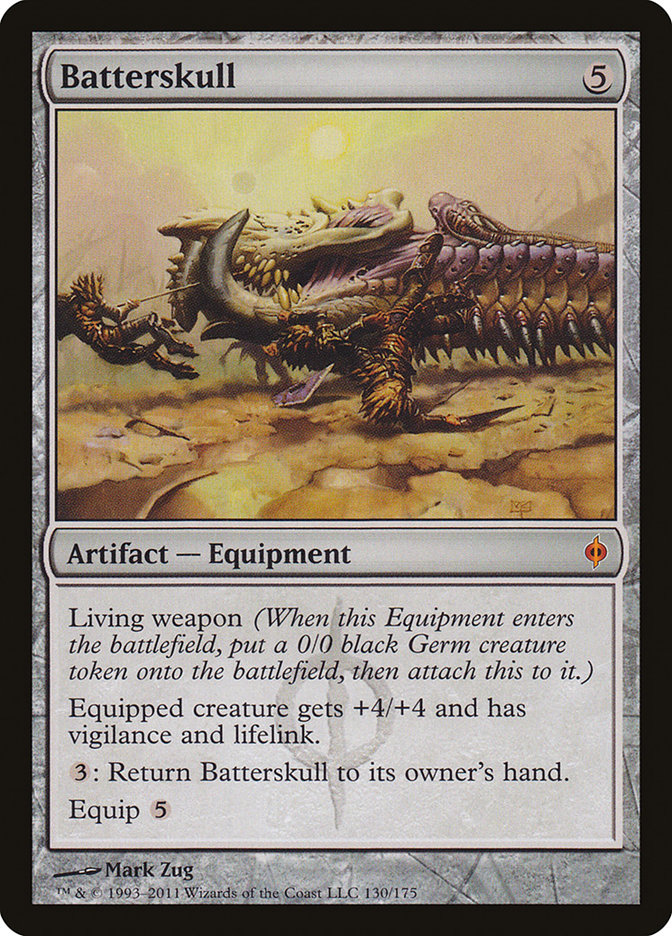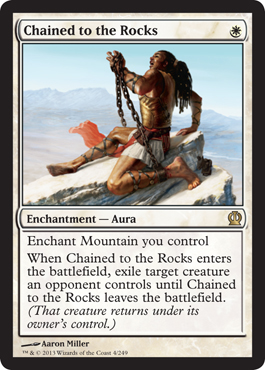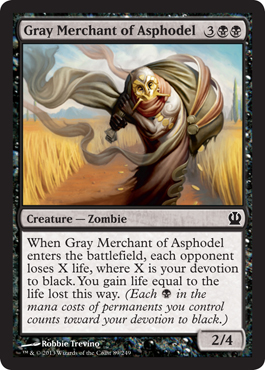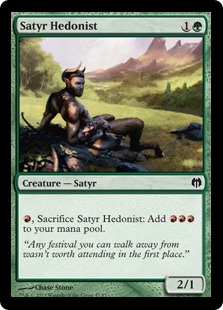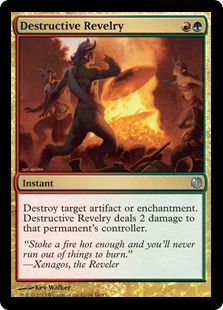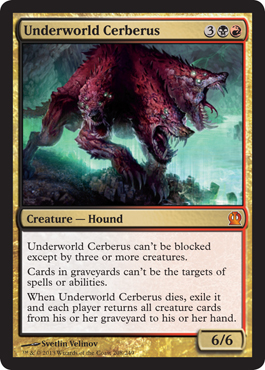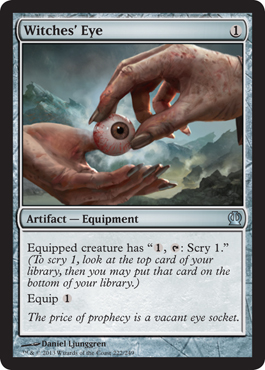First of all, let me say that I’m extremely excited for Theros. I’m secretly a giant Vorthos, and the flavor in this set is just awesome so far. Indulge me in a side note on being a Vorthos here.
I think a lot more people are Vorthoses than admit to it. For some reason it’s "cool" to not care about the flavor and just want to play Magic because it’s a great strategy game. I believe that flavor is a lot more important to gameplay and game design in Magic and other games than many realize. Good flavor allows us to remember and process mechanics that would be too complicated, confusing, or just random without flavor to tie them together and help us keep track of what’s going on.
I’m excited about sets that make Magic a better game, and I think Haunted Plate Mail makes for a better game than Batterskull. The strength of the cards aside, Haunted Plate Mail is just awesome—I can’t read that card and not imagine a suit of armor waking up and starting to move around, possibly to attack Link in a game of Zelda. On the other hand, all I really think of when I see Batterskull finding it with Stoneforge Mystic. The card just doesn’t make any sense.
Some of the most fun I have in Magic happens when someone points out something hilarious about the flavor of what’s happening in a game—it doesn’t always have to make perfect sense. For example, sometimes it’s just funny to imagine a bird carrying a sword, but it helps if I can just imagine what the pieces are. The better the flavor of the cards is, the more likely I am to have a great mental image come up sometime while playing a game.
Also, better flavor makes for better Walking the Planes videos, which is becoming increasingly important to me.
So what flavor am I so excited about? (Stay with me, I know I’m a strategy writer—this article won’t be all about flavor.)
Well, first of all, I’m blown away by the design of the Gods. I love that they managed to make them powerful but castable; when you summon them, they’ll help you out, but you have to be really devoted to get them to show up. After seeing Lucent Liminid, it was hard to imagine seeing enchantment creatures in a way that makes sense rather than just arbitrarily tacking more words into the type line because they can do that, but the Gods really feel like they need to be enchantments and creatures. (Well, it could just be an enchantment that becomes a creature, but it’s really nice to get to see the power and toughness in the lower right-hand corner. And given that the cards represent gods, it makes sense that they’re creatures in other zones).
I also like that they’re indestructible but not that annoying to deal with since you should just be able to break their devotion to make them stop being creatures. They’re probably all going to be good in Limited, but I wouldn’t count on getting to use them as creatures all that much, so they should be evaluated primarily as enchantments.
Outside of that, cards like Chained to the Rocks and Rescue from the Underworld are just clear 10/10 flavor hits, and the whole set just paints a very solid complete picture.
Finally, I’m delighted by how this set deals with mana issues. Monstrous and bestow reward players for having a lot of mana while still allowing them to play their cards with less mana, but more important is the return of scry. Scry is an awesome fit in terms of flavor and a great mechanic for gameplay. From the looks of it, they’re being conservative with the scry numbers (most things just have scry 1), but that’s perfect because it helps manage mana issues but doesn’t really set up combo decks. It also happens to coincide with Delver of Secrets rotating out of Standard fortunately. Bestow and monstrous also make scry more interesting since they mean that sometimes you’ll be trying to draw your eighth land and other times you’ll just want to put those off and try to find more action.
Ok, on to the meat of the issue; let’s talk about how these cards are going to play.
Chained to the Rocks is an outstanding removal spell. One mana to exile any creature without giving your opponent anything in exchange is way above the curve. It’s not an instant, so I don’t think it’s going to be replacing Swords to Plowshares in Legacy, but it could be a very big deal in Modern. It’s a completely different card with fetchlands, which is why I went straight to talking about older formats.
It will likely still see play in Standard, but it’s on an entirely different level when you can consistently have a Sacred Foundry or Plateau on the first turn. In Standard, it will be hard to use outside of two-color decks, but I can imagine U/W/R Control decks that plan to have the game go long enough that they’ll always draw one of their Scared Foundrys or Steam Vents eventually and then exiling a creature for one mana will be a big tempo play. It also serves as a nice replacement for Pillar of Flame, which will be rotating out.
While Chained to the Rocks is much weaker if the enchantment focus of the set leads to a lot of enchantment removal being played, it still permanently answers tokens, it gets a creature out of the way temporarily, and you’ll never come out behind on mana since you’ll generally get some value. If you’ll consistently have white mana and a Mountain early, this is going to be awesome. Also, as a nice perk, after exiling a creature it hangs around in play, counting toward your devotion, which is a nice bonus even if it’s somewhat unlikely that you’ll capitalize on it since you have to be playing a two-color deck.
Elspeth, Sun’s Champion is an interesting card to evaluate. Are we beginning to see an era of six-mana planeswalkers with this and Garruk, Caller of Beasts? This would be sweet in a G/W Elves/Ramp deck with Avacyn’s Pilgrim and Gavony Township, but both of those and Arbor Elf will be rotating out when we get Elspeth, Sun’s Champion, so it won’t be so easy to find a home for her. Still, her abilities are outstanding, particularly the +1, so she may end up being a finisher for control decks or the top of a midrange strategy.
As a control finisher, she’ll likely end up being compared to Aetherling. There, she costs less mana since you don’t want to play Aetherling without a mana up most of the time, and she stabilizes a board faster against large creatures or creatures without evasion. She’s not as reliable and I wouldn’t want to play her as my only way to win a game, but she’s definitely going to be better against most creature decks than Aetherling if you need something to catch you up from behind.
Gods Willing isn’t the kind of card we generally think of as a Constructed standout, but I think it’s worth commenting on here because it does something different than it would in another set, which is that it triggers heroic. Given that it only costs a single mana and that it has the benefit of scry 1, I think this spell will often be cast merely as "trigger heroic, scry 1" and the protection won’t matter. At the same time, that’s not exactly why it will be in a deck.
If you have a creature you’re planning to target a lot to trigger its heroic ability, you’re moderately likely to need to protect that creature, and this will likely be the best card to play to do that. As a result, I think this card, which would usually be a fine Limited filler card, is actually fairly likely to see Constructed play provided heroic ends up being a Constructed-level mechanic in white, which I have to imagine it will be (at least by the end of the block).
Thassa and her Bident could easily lead to a sweet blue aggro deck. As Patrick Chapin mentioned, we have a strong core of cheap evasive creatures with Cloudfin Raptor, Galerider Sliver, Judge’s Familiar, and Faerie Imposter, and Tidebinder Mage is an excellent aggressive creature once we’re in the market for a blue aggro creature that powers devotion. A natural curve of any one-drop; Tidebinder Mage; Thassa, God of the Sea; and then any other blue permanent allows Thassa, God of the Sea to attack on turn 4, so it wouldn’t be hard to attack with her even if something dies.
Moreover, the ability on Thassa as an enchantment to make creatures unblockable is obviously at home here. This deck will also take full advantage of Thassa by keeping its curve low, allowing it to scry away lands without fear of stranding any expensive spells, and playing cards like Voyage’s End will help supplement the scry theme that will keep the deck full of action going into the midgame.
Gray Merchant of Asphodel is an interesting card. Five is a lot of mana for a 2/4, but it’s not a lot of mana for a giant drain life. And even if all you have is a Dark Prophecy, this drains for five. Coincidentally, if I have a Dark Prophecy in play, that’s exactly what I want to be doing. I doubt it has a home outside of a deck with Dark Prophecy, and it’s obviously sad not to be able to play with Geralf’s Messenger and Restoration Angel. But Dark Prophecy is such an awesome devotion enabler that there could easily be a Dark Prophecy / Devotion to black (Dark Devotion) deck, and these would likely be two pieces of that deck.
Also, imagine playing one, playing another, and then using Rescue from the Underworld to bring them both back. I haven’t done the math, but I’m sure they take more than twenty from that line if there’s a Dark Prophecy in play.
I’m not sure what I want to do with Satyr Hedonist or what format I want to do it in, but I’m excited that WotC is still willing to print cards like this. The most obvious uses to me are casting Garruk, Call of Beasts or Ruric Thar, the Unbowed on turn 3, although I’d love it if people could dream big and use it to cast Borborygmos Enraged.
Destructive Revelry is an outstanding card, and if the enchantment theme really pans out, it might be a brutal maindeck spell and one of the major advantages to R/G. It’s also an excellent tool for aggressive R/G decks in Modern, especially Burn, giving it an awesome answer to Leyline of Sanctity.
Underworld Cerberus is one of those cards that I just look at and wonder how it can have so many advantages for such a reasonable cost but then fail to figure out what I would ever actually want to do with it. It’s also a prime example of a card that has a list of abilities that would be absolute gibberish without the top-down flavor holding it together. I don’t know what the creature-based R/B Aggro deck that wants to get to five mana looks like, but this guy is a huge clock that really punishes attrition-based control decks. It doesn’t have a casting cost that obviously fits with that kind of deck, but it might be worth trying to build around, particularly if you’re looking to punish something like Mono-Black Control.
Witches’ Eye isn’t a Constructed-playable card, but I have to mention that I love that the art shows the eye being handed off as a visual clue that the point of this card is that you can move it around between a lot of creatures to scry a lot.
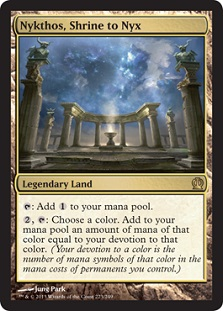
Nykthos, Shrine to Nyx might be the most exciting card so far. It’s probably not the best, and the fact that it taps for colorless mana in a deck that wants all of its cards to cost only or primarily colored mana is awkward. I love to potential for this to get huge, but it does it in a way that really isn’t abusable early. Cabal Coffers is a sweet card, and this is an awesome spiritual successor. It’s really hard to know what to do with this without seeing all the other devotion cards in the set, but I hope it finds a home.
Thanks for reading,
Sam
@samuelhblack on Twitter
twitch.tv/samuelhblack

